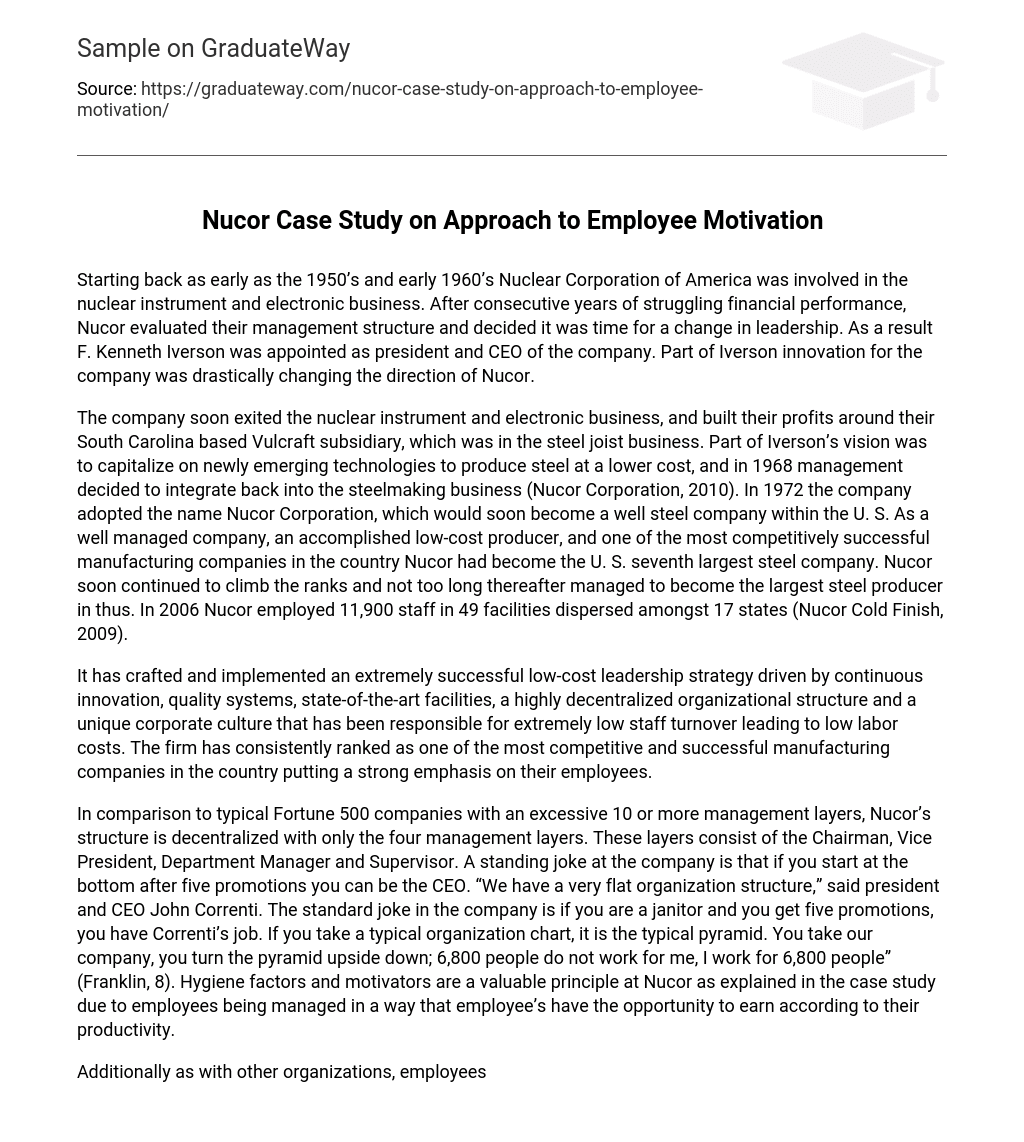Starting back as early as the 1950’s and early 1960’s Nuclear Corporation of America was involved in the nuclear instrument and electronic business. After consecutive years of struggling financial performance, Nucor evaluated their management structure and decided it was time for a change in leadership. As a result F. Kenneth Iverson was appointed as president and CEO of the company. Part of Iverson innovation for the company was drastically changing the direction of Nucor.
The company soon exited the nuclear instrument and electronic business, and built their profits around their South Carolina based Vulcraft subsidiary, which was in the steel joist business. Part of Iverson’s vision was to capitalize on newly emerging technologies to produce steel at a lower cost, and in 1968 management decided to integrate back into the steelmaking business (Nucor Corporation, 2010). In 1972 the company adopted the name Nucor Corporation, which would soon become a well steel company within the U. S. As a well managed company, an accomplished low-cost producer, and one of the most competitively successful manufacturing companies in the country Nucor had become the U. S. seventh largest steel company. Nucor soon continued to climb the ranks and not too long thereafter managed to become the largest steel producer in thus. In 2006 Nucor employed 11,900 staff in 49 facilities dispersed amongst 17 states (Nucor Cold Finish, 2009).
It has crafted and implemented an extremely successful low-cost leadership strategy driven by continuous innovation, quality systems, state-of-the-art facilities, a highly decentralized organizational structure and a unique corporate culture that has been responsible for extremely low staff turnover leading to low labor costs. The firm has consistently ranked as one of the most competitive and successful manufacturing companies in the country putting a strong emphasis on their employees.
In comparison to typical Fortune 500 companies with an excessive 10 or more management layers, Nucor’s structure is decentralized with only the four management layers. These layers consist of the Chairman, Vice President, Department Manager and Supervisor. A standing joke at the company is that if you start at the bottom after five promotions you can be the CEO. “We have a very flat organization structure,” said president and CEO John Correnti. The standard joke in the company is if you are a janitor and you get five promotions, you have Correnti’s job. If you take a typical organization chart, it is the typical pyramid. You take our company, you turn the pyramid upside down; 6,800 people do not work for me, I work for 6,800 people” (Franklin, 8). Hygiene factors and motivators are a valuable principle at Nucor as explained in the case study due to employees being managed in a way that employee’s have the opportunity to earn according to their productivity.
Additionally as with other organizations, employees should feel confident that if they do their jobs properly, they will have a job the following day as for compensation, Nucor provides employees with a performance-related. As reported in Nucor Cold Finish, all employees were covered under basic compensation plans, each featuring incentives related to meeting specific goals and targets as being treated fairly is equally important. Next is a production incentive plan which under this plan, employees directly involved in manufacturing were paid weekly bonuses based on actual output in relation to anticipated production tonnages produced.
The bonuses were paid only for work that met quality standards and were specific to work groups, rather than individual output. Once the standard output was determined, it was not revised unless there was a significant change in the way a production process was performed due to a source other than the workers in the bonus group. Bonuses were linked to attendance and tardiness standards. If one worker’s punctuality or attendance issues caused the group to miss its weekly output target, every member of the group was denied a bonus for that week.
After an analysis of the Nucor case study, it is concluded there are many different theories which include satisfaction, behavior modification, and expectancy theories that try to explain what motivates people and how their behavior is an influence to their motivation. However, none of these specifically provide an approach or method of motivating employees. Also it is fair to assume that one theory is not better than the other. Each theory provides managers with some guidance on appropriate ways of motivating employees, and each theory has some limitation.
A recommendation to a manager would be understand these and other theories such as Maslow’s, Alderfer’s, and McClelland’s’ need theories to gain insights into nature and process of motivation, and to use these insights gained to guide their decisions and behavior impacting employee motivation. In order to be effective, managers need to pay attention to motivation in many different aspects of their work and decisions such as interacting with their employees in course of routine day to day working.
Evaluating, rewarding employees and taking disciplinary actions as necessary are effective methods in managing individuals. Moreover, the expectancy theory of motivation has become a commonly accepted theory for explaining how individuals make decisions regarding various behavioral alternatives. As demonstrated in the case study, employees opted to drop what they were doing to head in to troubleshoot the problem. More likely than not it would be difficult for other companies to copy Nucor’s approach although companies reputation has been established over time.





